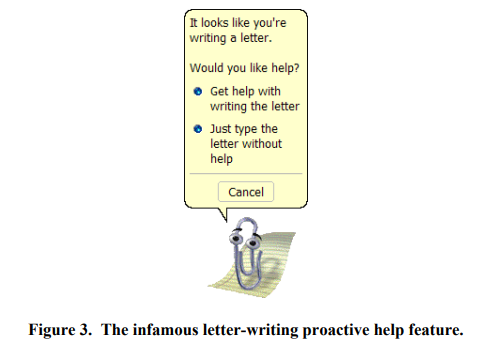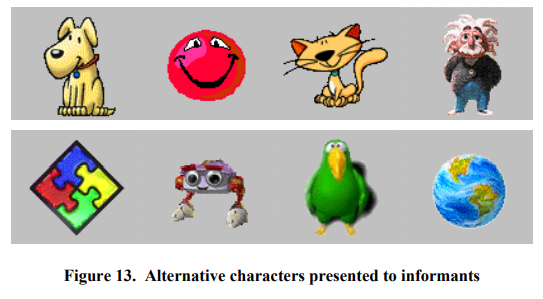Spurred by this week’s prompt being “what is an early memory of digital technology”, I took a deep dive in my childhood. Suddenly I remembered an old friend: Clippert, nicknamed Clippy – or Trombine if like me your parents used Microsoft’s softwares in French. I remember my mother using Microsoft Word and seeing this animated paperclip changing appearances as she hit commands on the keyboard fascinated me – you don’t see a paperclip shapeshifting into a bike and riding into the horizon that often after all. Reading was still far from my forte, still the paperclip-shaped assistant proved to be an experimentation companion for hours on end – the range of animations kept getting bigger and I wanted to catch see them all. Years passed, computers’ OS got updated and gone was my paper-clippy companion. How did this come about? Let me give you a bit of background and how this helped making better AI assistants.

Clippy history and retirement
So, who is Clippy really? Clippy is an intelligent user interface for the text software Microsoft Office. This virtual assistant helped users in Microsoft Office (versions 97 to 2003), Microsoft Publisher and Microsoft Project (versions 98 to 2003), Microsoft FrontPage (versions 2002 and 2003), and Microsoft Office for Mac (versions 98 to 2004) (Wikipedia 2022). Clippy appeared when the aforementioned programs detected that the user could use some help or when the programs decided that users could use the programs more efficiently. An example of this is Clippy appearing after the input of a salutation in Microsoft Office – take “Dear client” for example – to give advice on how to formulate the contents of a letter. Aside from Clippy, users could download a dozen of specialized virtual assistants through the Office installation CD.

Clippy is the spiritual successor to Microsoft Bob – a program used to introduce users to the functions of a computer in a friendly and homely manner through the decor of a home and cartoon characters giving out tips. This program was introduced in 1995 and discontinued soon after in 1996. Clippy also received a bad rep, so bad that Microsoft made a particularly verbally explicit ad campaign out of disabling Clippy when introducing Office XP in 2001 before really putting Clippy to retirement in Office 2007 and Office 2008 for Mac. But why did both products fail? The answer lies in part with the anthropomorphic approach, see next section.
“It looks like you’re writing a letter” ad infinitum & other reasons to hate world’s most famous paperclip
According to Alan Cooper – an important figure in the field of software design – the anthropomorphic design of virtual assistants stems from a misunderstanding of research conducted at Stanford University. The pioneering research showed that people interact with computers as they would with other humans (the Computers as Social Actors paradigm or CASA). Microsoft’s answer to this research was to include human-like assistants in their products. Cooper argues however that this added human-like assistant then acts as a distraction from the task at hand, leading to frustration.
This point is further expanded upon by Swartz: he first points out that the use of an anthropomorphic assistant can lead to unrealistic expectations towards the capabilities of said assistant, which leads to “anthropomorphic dissonance” (Swartz 2003, 15). Then, applying the CASA paradigm, Swartz finds that Clippy’s behavior breaks many rules of human-to-human interaction etiquette – being repetitive, staring, and not learning from user’s preferences for example (Swartz 2003, 22-23). Full disclosure: I vividly remember my mother’s exasperation after Clippy’s n-th request to format her name to a “correct” spelling or Clippy’s idle animation running while she tried to write on an already slow computer.
Conclusion: how to not AI
This blog post about Clippy’s notoriously annoying AI shows just how far artificial assistants have changed. Nowadays Cortana, Siri, Bixby and other popular digital assistants adopt another approach: users request their help, the assistants use user’s preferences for more accurate suggestions and the use of an anthropomorphic design is not in use. My guess is that Clippy served as the embodiment for everything an AI assistant should not be. Still, the paperclip can count on some fans who made sure that Clippy will live on in the form of memes, stickers and even an emoji. Long live Clippy!
References
All sources were last consulted on 2022-09-26.
https://en.wikipedia.org/wiki/Office_Assistant
https://archive.org/details/g4tv.com-video4080
https://www.coli.uni-saarland.de/courses/agentinteraction/contents/papers/Nass00.pdf
http://xenon.stanford.edu/~lswartz/paperclip/paperclip.pdf
https://knowyourmeme.com/memes/clippy
https://www.onmsft.com/news/microsoft-teams-clippy-sticker-packhttps://www.onmsft.com/news/microsoft-will-be-resurrecting-clippy-as-its-new-office-paperclip-emoji



Recent Comments